Table of Contents
- Introduction
- Editor’s Choice
- Meal Kit Delivery Services Market Overview
- Global Meal Kit Users Statistics
- Global Meal Kit Delivery Market Overview
- Revenue Generation Through Meat Kit Delivery Services
- Consumer Preferences and Trends
- Impact of COVID-19
- Advantages and Benefits
- Issues and Challenges
- Regulations for Meal Kit Delivery Services
Introduction
According to Meal Kit Delivery Services Statistics, Meal Kit Delivery Services simplify home cooking by delivering pre-portioned ingredients and detailed recipes directly to customers’ doorsteps on a subscription basis.
These services offer various meal options, including vegetarian, vegan, and gluten-free choices, catering to diverse dietary preferences.
Ingredients are typically fresh and often sourced locally or organically. Despite being more expensive per meal than grocery shopping, meal kits provide convenience by eliminating the need for shopping and meal planning.
The industry is competitive, with leaders distinguishing themselves through menu variety, pricing strategies, and sustainability efforts, reflecting a growing consumer preference for convenient yet quality meal solutions.
Editor’s Choice
- The global meal kit delivery services market revenue reached USD 88.97 billion by 2033.
- The growth trajectory continues with expected revenues of USD 47.80 billion in 2029, USD 55.84 billion in 2030, USD 65.22 billion in 2031, USD 76.17 billion in 2032, and USD 88.97 billion in 2033.
- A significant disparity in market share between single and multiple service offerings characterizes the global meal kit delivery services market. Single-service offerings dominate the market, accounting for 58.60% of the total market share.
- In the global meal kit delivery services market, the distribution of market share by platform reveals a strong preference for online platforms. Online platforms command a substantial 64.10% of the market share. Indicating a significant consumer inclination towards digital channels for meal kit purchases.
- The global meal kit delivery services market is characterized by a diverse range of key players. Each contributes to the overall market dynamics. Blue Apron, LLC leads the market with a 12% share.
- The global meal kit delivery services market is geographically segmented, with North America leading the market with a dominant 47.3% share.
- In March 2020, the expected changes in spending on meal kit delivery services in the United States due to the coronavirus pandemic revealed varied consumer expectations. A majority of respondents, 62%, anticipated no change in their spending on meal kit delivery services.
Meal Kit Delivery Services Market Overview
Global Meal Kit Delivery Services Market Size
- The global meal kit delivery services market has exhibited robust growth at a CAGR of 16.8%. With revenue rising from USD 16.12 billion in 2022 to an anticipated USD 88.97 billion by 2033.
- In 2023, the market revenue reached USD 18.83 billion, followed by USD 21.99 billion in 2024.
- The revenue is projected to reach USD 65.22 billion by 2031, USD 76.17 billion in 2032, and culminate at USD 88.97 billion by 2033.
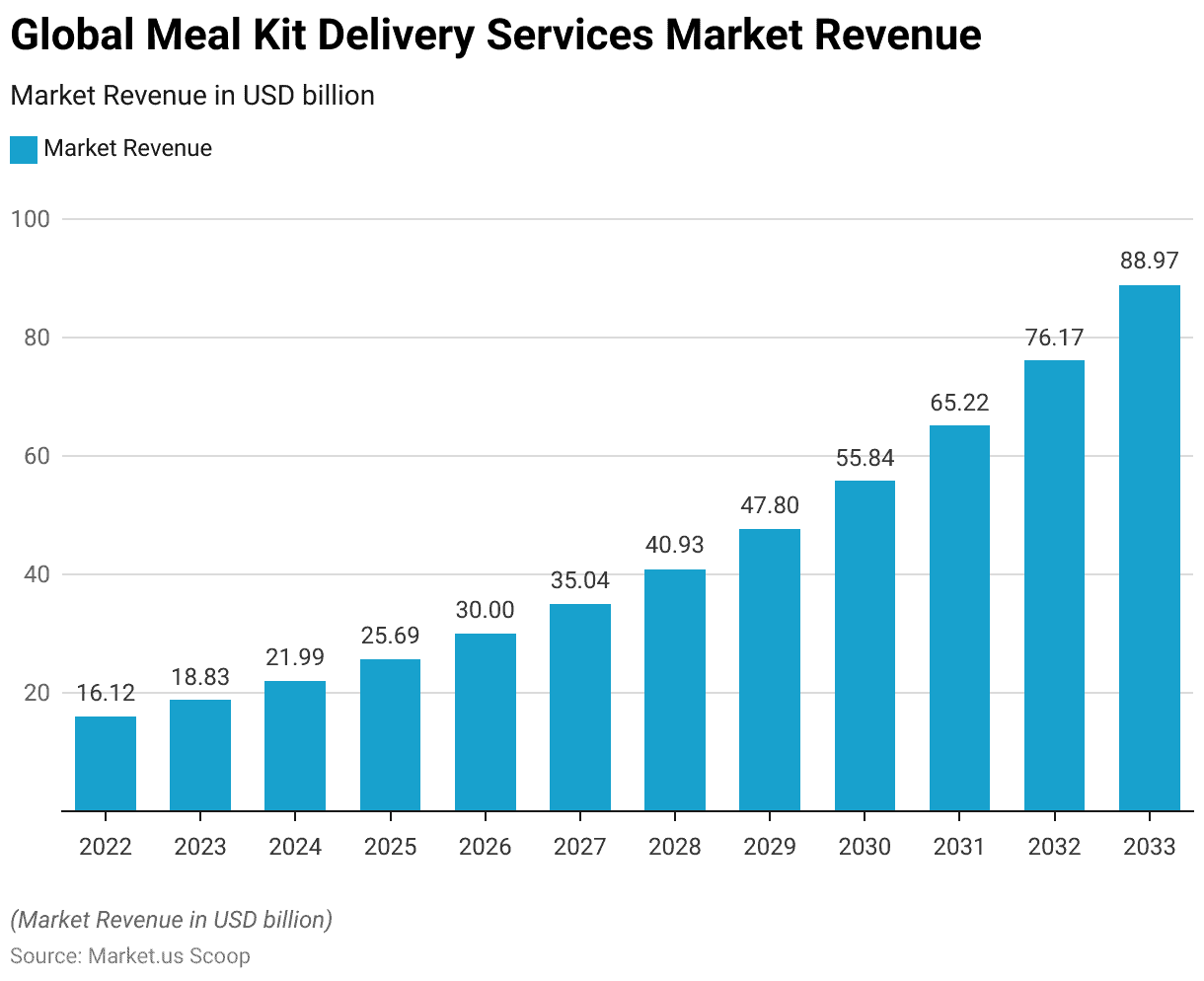
Global Meal Kit Delivery Services Market Size – By Offering
- The global meal kit delivery services market, segmented by offering, has shown substantial growth from 2022 to 2033.
- In 2022, the total market revenue was USD 16.12 billion, with “Cook & Eat” services contributing USD 9.90 billion and “Heat & Eat” services accounting for USD 6.22 billion.
- The growth trajectory continues with expected revenues of USD 47.80 billion in 2029, USD 55.84 billion in 2030, USD 65.22 billion in 2031, USD 76.17 billion in 2032, and USD 88.97 billion in 2033.
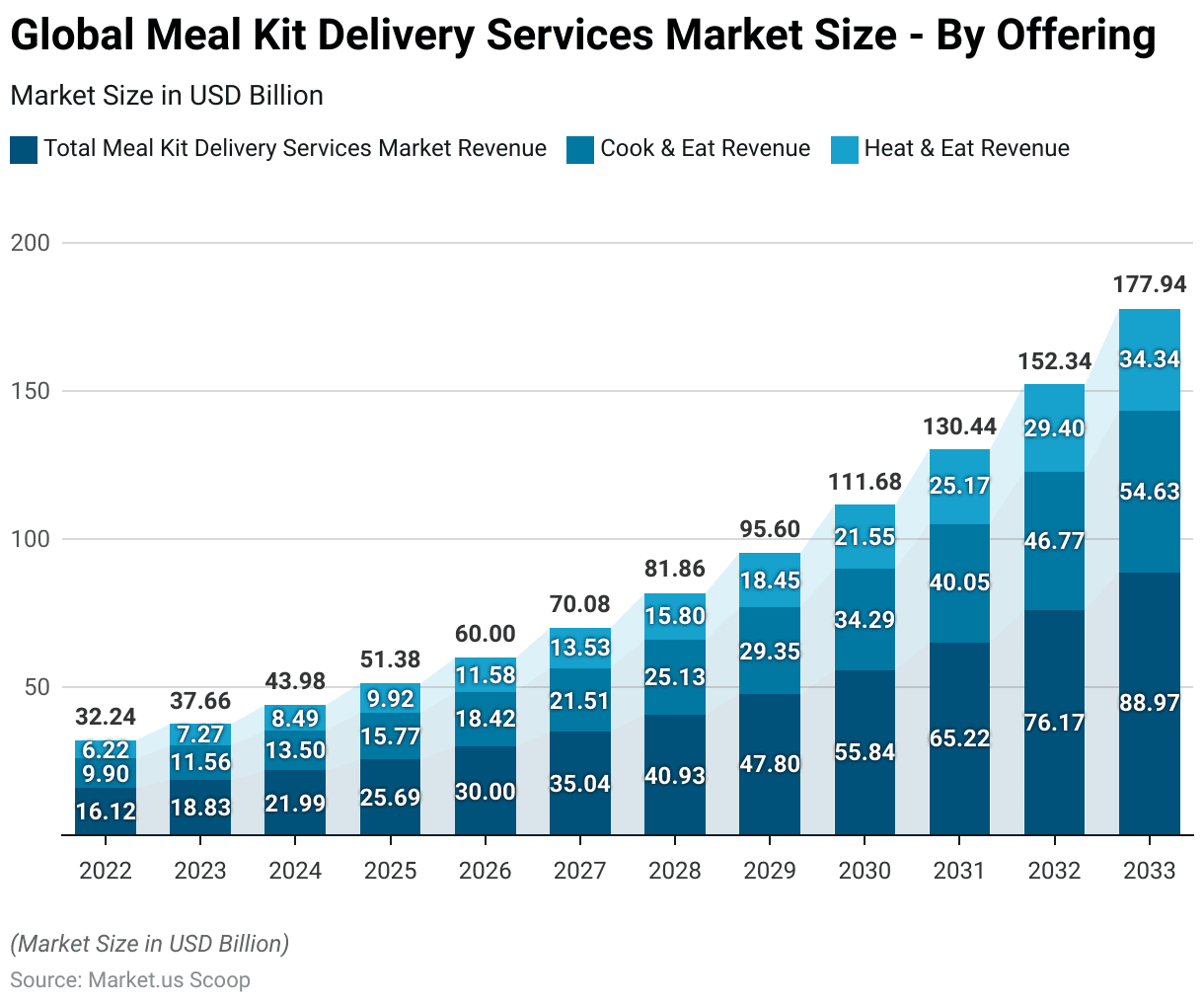
Competitive Landscape of Global Meal Kit Delivery Services Market
- The global meal kit delivery services market is characterized by a diverse range of key players. Each contributes to the overall market dynamics.
- Blue Apron, LLC leads the market with a 12% share, followed closely by Freshly Inc. and HelloFresh, each holding an 11% share.
- Sun Basket also commands an 11% market share, indicating a competitive landscape among the top companies.
- Relish Labs LLC and Gobble each capture 10% of the market, while Marley Spoon Inc. holds a 9% share.
- Purple Carrot and Fresh n’ Lean account for 8% and 7% of the market, respectively.
- Hungryroot contributes 6% to the market share, with other key players collectively comprising the remaining 5%.
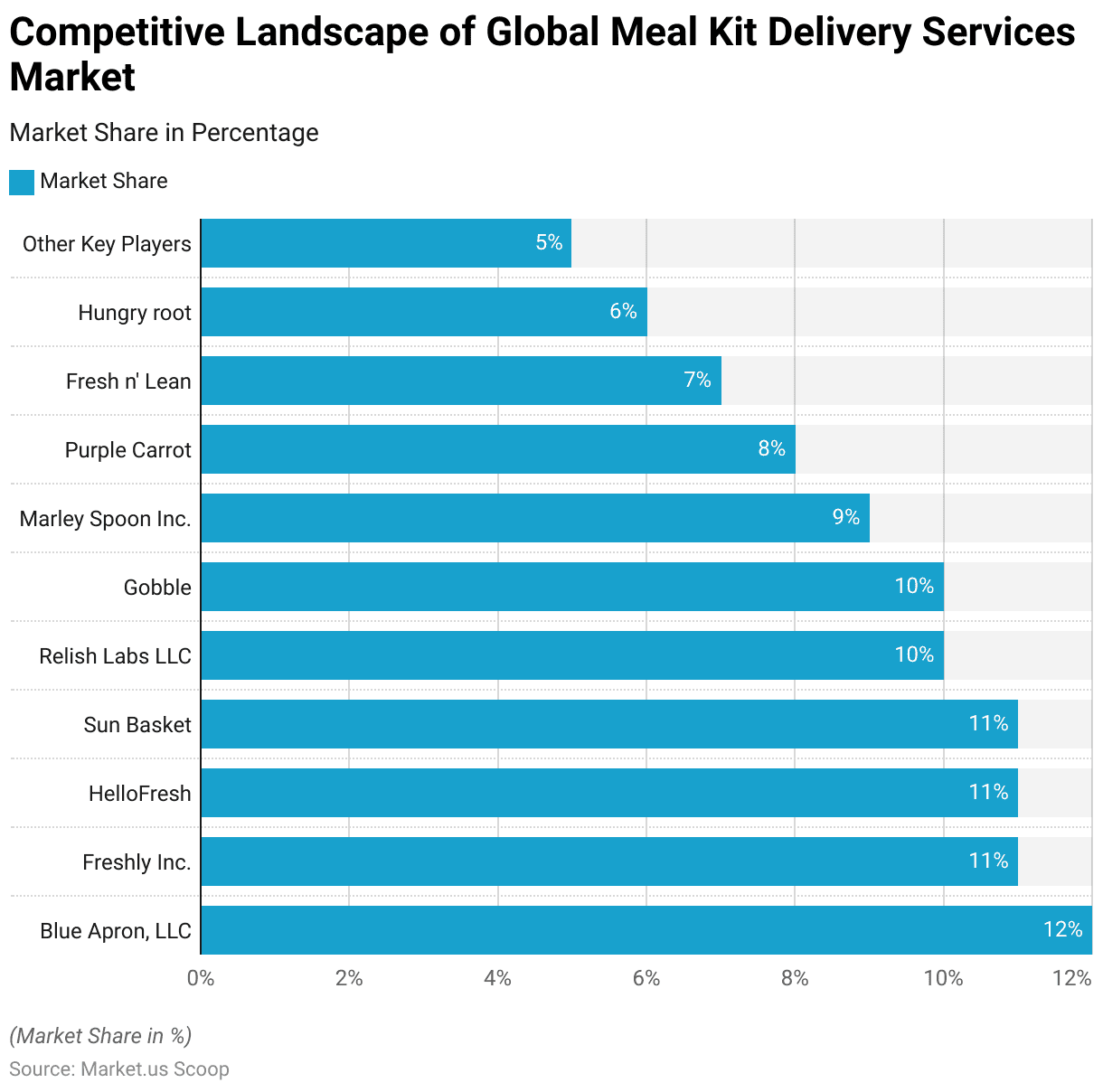
Regional Analysis of Global Meal Kit Delivery Services Market
- The global meal kit delivery services market is geographically segmented. North America leading the market with a dominant 47.3% share.
- This is followed by the Asia-Pacific (APAC) region, which holds a substantial 26.3% share. Reflecting significant growth and adoption in this area.
- Europe accounts for 19.0% of the market share, indicating a strong presence in the region.
- South America and the Middle East & Africa (MEA) contribute smaller shares, at 5.0% and 2.4% respectively.
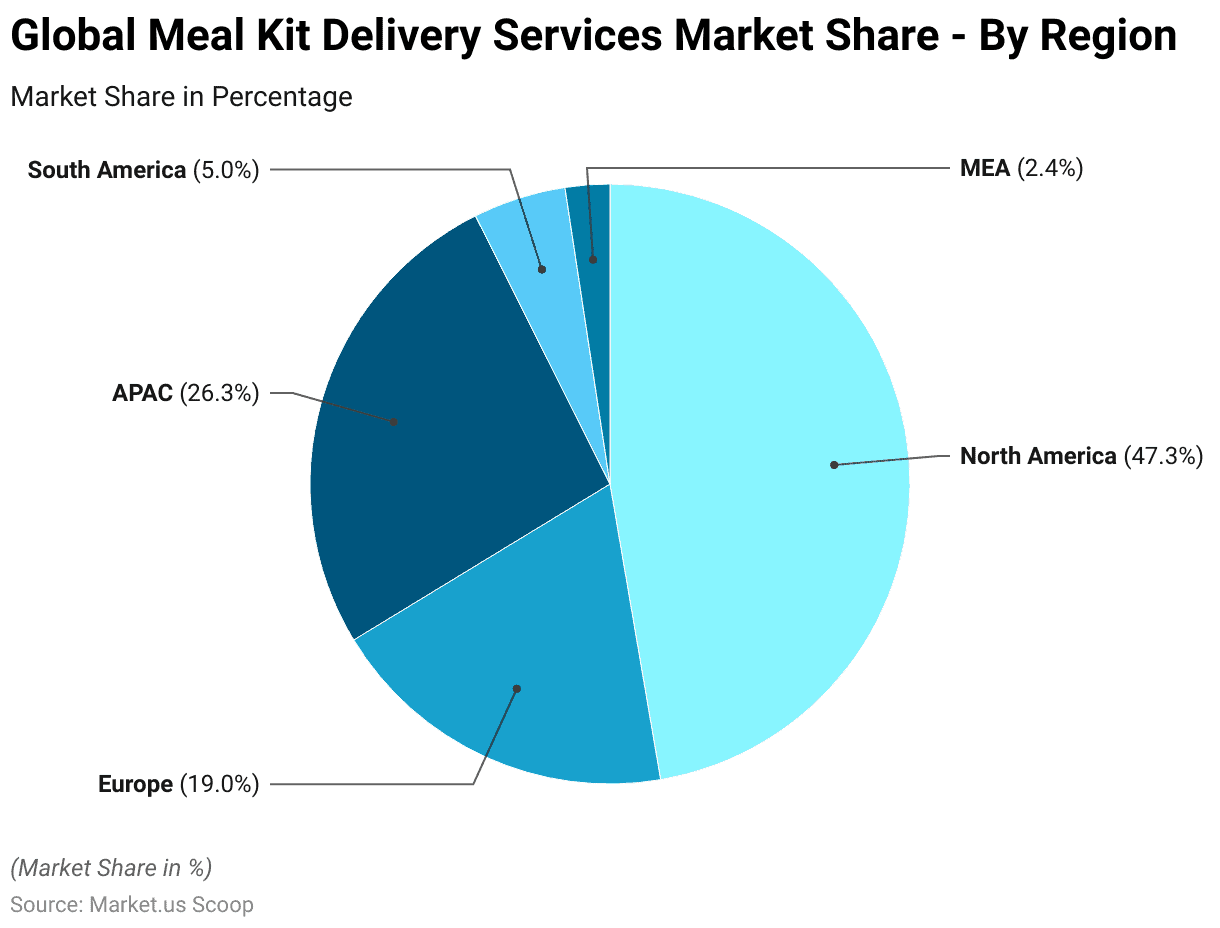
Global Meal Kit Users Statistics
Number of Meal Kit Users Worldwide and Penetration Rate
- The global meal kit delivery market has shown a steady increase in the number of users and a gradual rise in market penetration rates over the years.
- In 2017, there were 9.4 million users worldwide, corresponding to a penetration rate of 0.1%. This number grew to 10.7 million users in 2018 and 12.2 million in 2019. The penetration rate remained at 0.1% initially but increased to 0.2% by 2019.
- Projections for the following years show a consistent increase in users: 21.2 million in 2024, 22.2 million in 2025, 23.3 million in 2026, 24.1 million in 2027, 24.6 million in 2028, and reaching 25.0 million by 2029, with the penetration rate stabilizing at 0.3%.

Global Meal Kit Delivery Market Overview
Global Meal Kit Delivery Market Revenue
- The global meal kit delivery market has experienced substantial revenue growth from 2017 to 2029 at a CAGR of 4.57%.
- In 2017, the market generated USD 4.34 billion, which increased to USD 5.11 billion in 2018 and USD 6.14 billion in 2019.
- By 2027, the market is anticipated to generate USD 15.67 billion, and this upward trajectory continues with USD 16.19 billion projected for 2028, culminating in USD 16.58 billion by 2029.
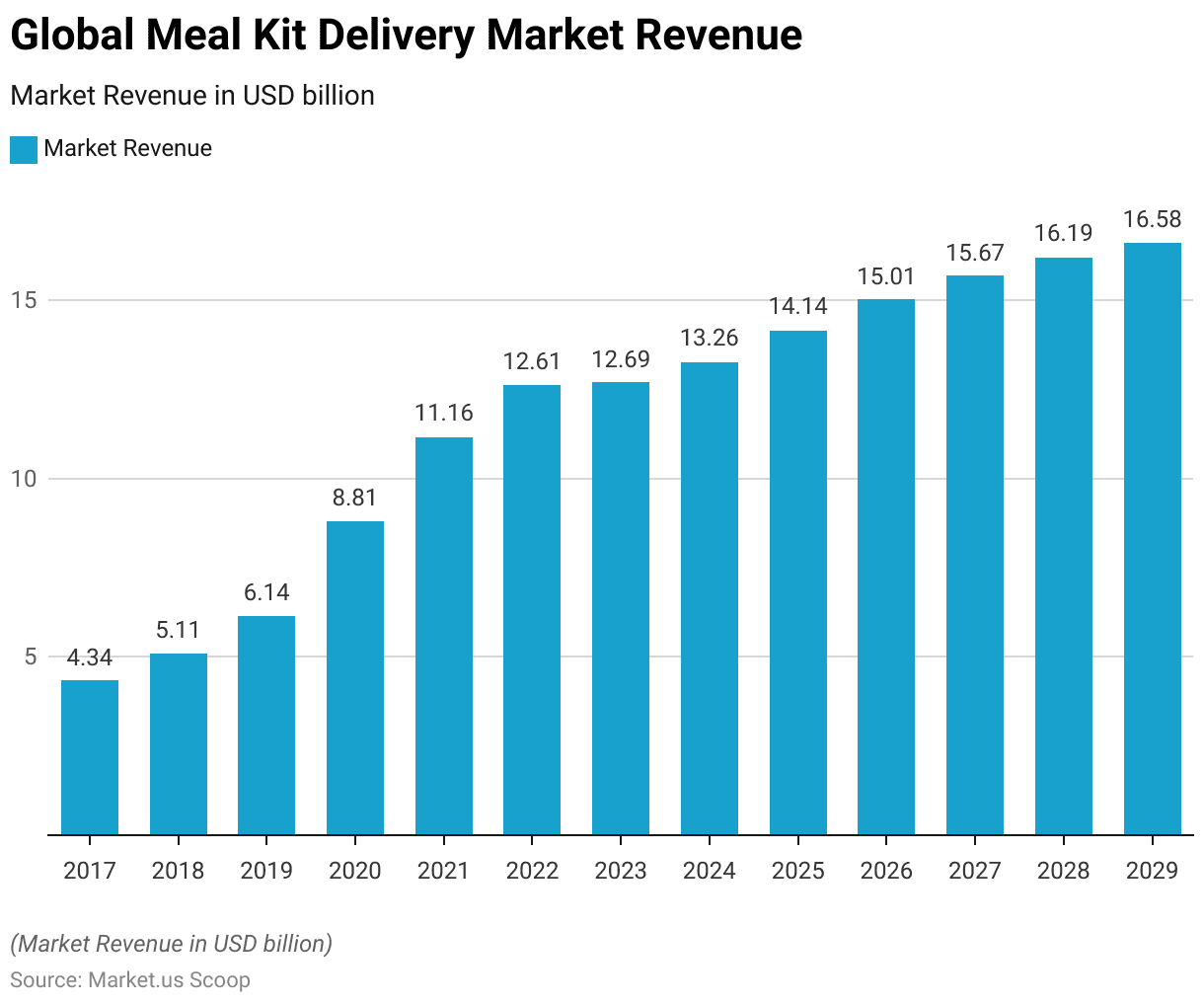
Meal Kit Delivery Market Revenue – By Country
- The meal kit delivery market revenue is notably concentrated in several key countries.
- The United States leads with a substantial revenue of USD 5,645 million, reflecting its dominant position in the global market. Japan follows with USD 1,684 million, indicating strong market adoption.
- The United Kingdom also demonstrates a significant market presence with USD 1,396 million in revenue.
- Canada and Australia contribute USD 1,066 million and USD 570.40 million, respectively, showcasing their growing markets.
- Germany’s revenue stands at USD 455.60 million, while Sweden accounts for USD 341.20 million.
- In the Pacific region, New Zealand generates USD 256.10 million.
- France, Denmark, and Norway contribute USD 202.40 million, USD 174.20 million, and USD 158.70 million, respectively.
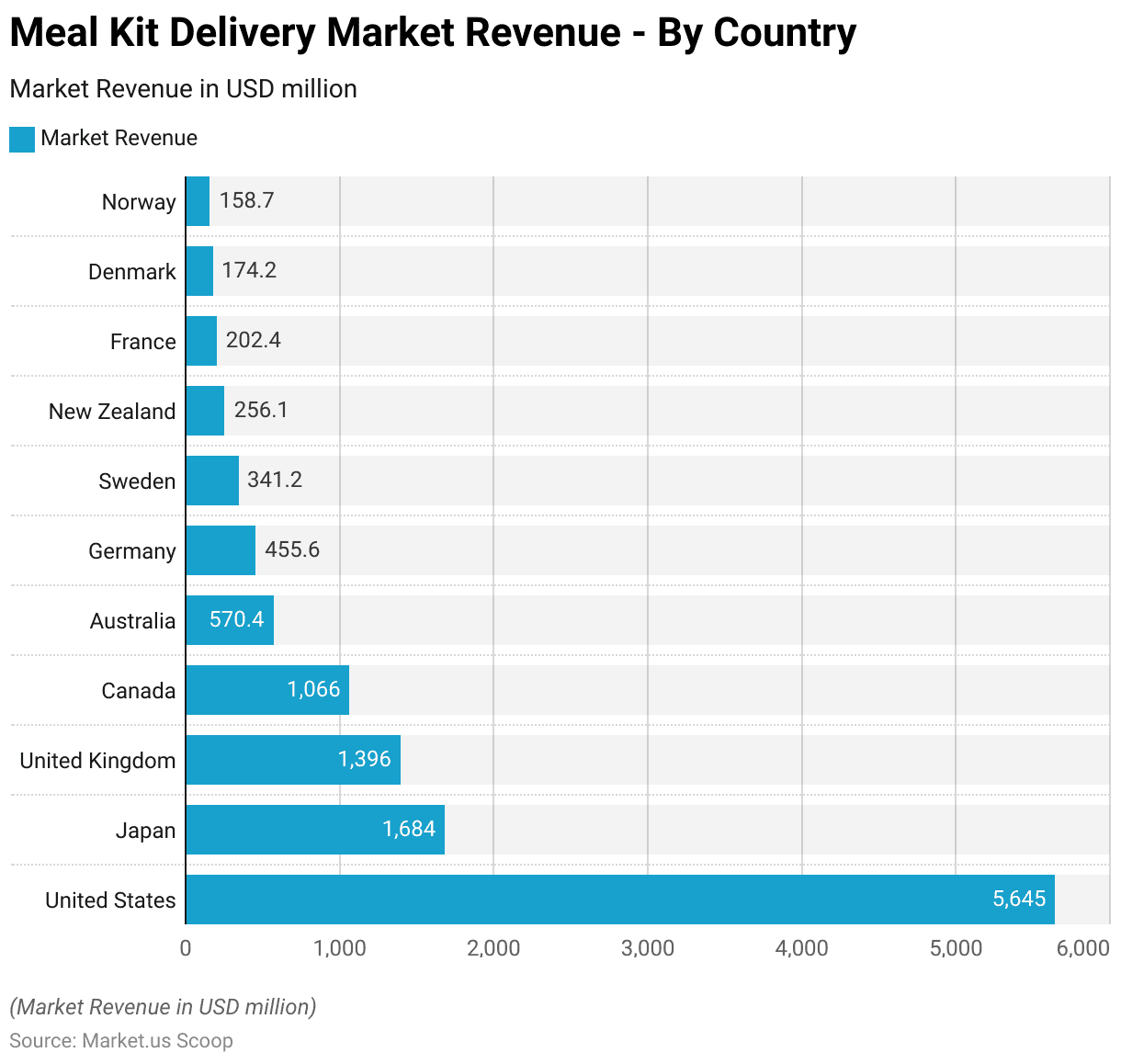
Revenue Generation Through Meat Kit Delivery Services
- Revenue generation through meal kit delivery services has seen a steady increase in average revenue per user (ARPU) from 2017 to 2029.
- In 2017, the ARPU was USD 0.46 thousand, which rose to USD 0.48 thousand in 2018 and further to USD 0.51 thousand in 2019.
- The ARPU is anticipated to increase further to USD 0.65 thousand in 2027 and USD 0.66 thousand in 2028 and stabilize at USD 0.66 thousand in 2029.

Consumer Preferences and Trends
Weekly Consumption of Meal Kit Meals
- The weekly consumption of meal kit meals among respondents shows a diverse range of usage patterns.
- A notable 33.6% of respondents reported consuming three meal kit meals per week, the highest share among the groups.
- Those consuming two meal kit meals per week accounted for 23.2% of respondents. While 22.1% reported having one meal kit meal per week.
- Additionally, 12.4% of respondents consumed five or more meal kit meals weekly, and 8.8% reported consuming four meal kit meals per week.

Reasons for Using Food Delivery Services
- Respondents cited several reasons for using food delivery services, reflecting diverse motivations.
- The most common reason, reported by 47.9% of respondents, was the convenience of cooking their meals.
- Additionally, 19.6% used delivery services instead of going out to eat at a restaurant. While 19.2% preferred delivery over getting takeout at a restaurant.
- Eating a ready meals prepared meal was the reason for 6.8% of respondents, and 6.5% stated they wouldn’t have eaten otherwise.
Impact of COVID-19
Change in Consumer Spending On Meal Kit Delivery Due to COVID-19
- In May 2020, consumer spending on meal-kit delivery services in the United States exhibited varied expectations across different generations due to the coronavirus pandemic.
- Among GenZers (born 1997-2012), 15% anticipated an increase in spending, 47% expected no change, 13% predicted a decrease, and 25% were uncertain or had no opinion.
- Millennials (born 1981-1996) showed a slightly lower inclination to increase spending, with 13% expecting to spend more, 57% anticipating no change, 11% foreseeing a decrease, and 18% undecided or without an opinion.
- Gen Xers (born 1965-1980) had 9% expecting to spend more, 62% seeing no change, 11% predicting less spending, and 18% uncertain or without an opinion.
- Baby Boomers (born 1946-1964) were the least likely to increase their spending, with only 4% expecting to spend more, 60% anticipating no change, 13% predicting a decrease, and 24% unsure or without an opinion.
Advantages and Benefits
- In 2018, consumers in the United States identified several advantages of online meal kit delivery services.
- The primary benefit noted by 43% of respondents was convenience.
- Additionally, 37% appreciated that meal kits helped them explore new tastes, while 33% valued not having to think about what to cook.
- Time-saving was another significant advantage, cited by 32% of respondents.
- Health benefits were recognized by 27%, and 20% appreciated that meal kits taught them how to cook, saved money, and brought their family together.
- Furthermore, 15% found meal kits useful for obtaining specific items not available in stores, 14% believed they provided better quality products, and 12% valued the fresher produce.
- Lastly, 8% of respondents considered meal kits more sustainable than making individual car trips to the store.
Issues and Challenges
- In Australia, the incidence of issues with meal kit delivery services varies by company.
- For Dinnerly, 50% of respondents reported never experiencing issues, while 15% encountered problems rarely, 24% sometimes, and 11% often.
- HelloFresh users reported no issues 50% of the time, with 28% rarely, 15% sometimes, and 8% often experiencing issues.
- Marley Spoon had 40% of respondents indicating no issues, 34% rarely, 17% sometimes, and 9% often.
- EveryPlate had the highest rate of trouble-free deliveries, with 57% of respondents reporting no issues, 28% rarely, 12% sometimes, and 3% often encountering problems.
- Overall, 50% of respondents across all companies reported never facing issues, 26% rarely, 16% sometimes, and 8% often.
Regulations for Meal Kit Delivery Services
- Regulations for meal kit delivery services vary significantly by country, reflecting different approaches to food safety and consumer protection.
- In the United States, meal kit delivery services are not universally regulated by the Food and Drug Administration (FDA).
- In contrast, the European Union imposes stricter regulations on meal kit delivery services, ensuring compliance with EU food safety laws. These regulations mandate rigorous standards for food handling, storage, and transportation to prevent contamination and ensure the freshness of ingredients upon delivery.
- Australia has similar stringent regulations, requiring delivery services to comply with national food safety standards. These include proper labeling, traceability of ingredients, and maintaining cold chain logistics to ensure food safety from the point of origin to the consumer’s doorstep.
Discuss your needs with our analyst
Please share your requirements with more details so our analyst can check if they can solve your problem(s)



